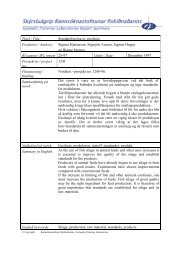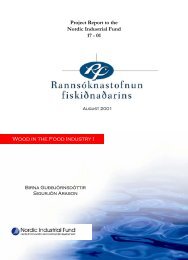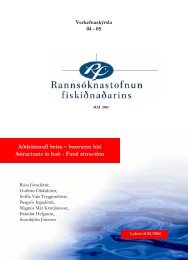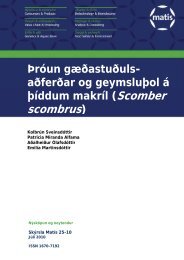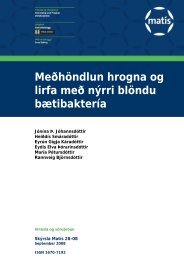Microbiology and Spoilage Trail in Nile Perch (Lates niloticus), Lake ...
Microbiology and Spoilage Trail in Nile Perch (Lates niloticus), Lake ...
Microbiology and Spoilage Trail in Nile Perch (Lates niloticus), Lake ...
Create successful ePaper yourself
Turn your PDF publications into a flip-book with our unique Google optimized e-Paper software.
4.2.2.2 Chemical analysis<br />
Changes of total volatile base nitrogen (TVB-N) <strong>in</strong> chilled <strong>Nile</strong> perch fillets stored at 0-3 o C is<br />
shown <strong>in</strong> figure 12. The TVB-N showed a stable trend with low <strong>in</strong>crease <strong>in</strong> the first 12 days<br />
of storage (6.72-7.67mgN/100g of fillet). Then the levels rapidly <strong>in</strong>creased up to<br />
26.92mgN/100g after 23 days of storage. The values are below the acceptability limits of 30-<br />
35mgN/100g. In view of these slow changes dur<strong>in</strong>g the first 2 weeks <strong>and</strong> steady <strong>in</strong>creas<strong>in</strong>g<br />
after 23 days of storage time, the TVB-N is not a good <strong>in</strong>dicator for mak<strong>in</strong>g decision on<br />
freshness quality of chilled fillets. The change <strong>in</strong> pH was from 6.4 to 7.0 units dur<strong>in</strong>g 23 days<br />
storage time.<br />
Figure 11: Changes of specific spoilage<br />
organism (SSO), total viable counts<br />
(TVC) <strong>and</strong> Enterobacteriaceae (Ent.) <strong>in</strong><br />
chilled fillets from newly caught <strong>Nile</strong><br />
perch.<br />
48<br />
Figure 12: Changes of TVB-N <strong>in</strong><br />
chilled fillets from newly caught <strong>Nile</strong><br />
perch.<br />
The specific micro flora (SSO, TVC) sharply <strong>in</strong>creased at the bign<strong>in</strong>g of storage <strong>and</strong><br />
followed with a constant <strong>in</strong>crease. The Enterobacteriaceae changes showed general lag<br />
phase at the first 2 weeks of storage but steady <strong>in</strong>crease for the rema<strong>in</strong><strong>in</strong>g storage period <strong>and</strong><br />
chemical changes were stagnant dur<strong>in</strong>g 13 days of atorage (figure 13). Rapid changes<br />
occurred dur<strong>in</strong>g 2-3 week of storage, then a constant /stationary phase were noted <strong>in</strong> all<br />
microbiological counts <strong>and</strong> TVB-N depicted exponential <strong>in</strong>crease up to the end of storage<br />
time (23 days).




